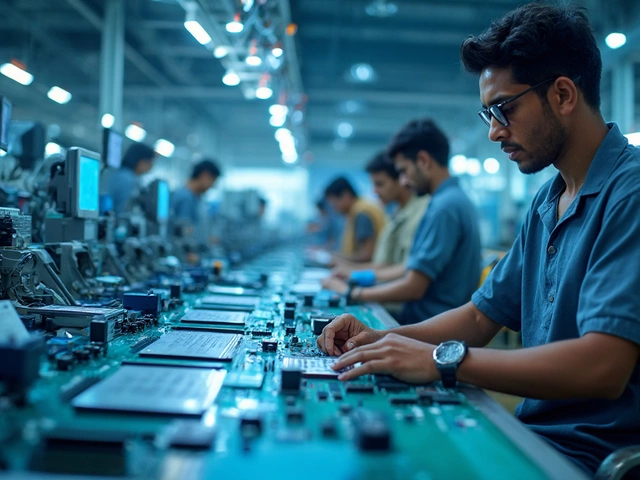Chances are, you’ve held a phone or clicked a mouse made in India without even knowing it. Factory floors in cities like Noida, Chennai, and Bengaluru are hot right now, churning out everything from cheap circuit boards to slick smartphones. There’s a real buzz as major global tech brands set up shop, but what’s really going on behind the scenes?
People often picture lines of workers or news about big government plans, but there’s a lot more to the story. For years, India was seen as a place that just assembled stuff designed elsewhere. Now, the script is flipping. India doesn’t just want to build electronics for other countries—it wants to own the entire value chain, from design to the final box on your doorstep.
If you’re thinking about launching a new gadget, starting an electronics startup, or even just curious why your next phone may say ‘Made in India’ on the back, understanding how fast things are changing on the ground is key. Let’s break down what’s behind India’s tech surge, what hurdles still trip up its factories, and which opportunities are flying under the radar for people who want to get in on the action.
- India's Surprising Rise in Electronics
- Big Names Betting on India
- What's Working: Homegrown Innovations
- Challenges Nobody Talks About
- Can India Lead in Cutting-Edge Tech?
- How You Can Benefit from India's Tech Push
India's Surprising Rise in Electronics
Blink and you might have missed it: just a decade ago, most electronics you bought in India were either fully imported or at best, assembled using parts made in China or Taiwan. Today, it’s a whole different ball game. India electronics manufacturing plants are popping up everywhere—Noida alone is called India’s “Mobile Manufacturing Hub,” with over 30 factories making phones for brands you actually recognize.
What fired up this dramatic shift? Plain and simple: government incentives. In 2020, the government rolled out the Production Linked Incentive (PLI) scheme, basically rewarding companies for every phone, chip, or TV they made locally. The impact was crazy fast. You know Apple? They started making iPhones in India. Oppo, Samsung, Lava—they’re all here. In fact, India became the world’s second biggest mobile phone producer in 2023, just behind China.
| Year | Mobile Phones Produced (Million Units) |
|---|---|
| 2014 | 60 |
| 2023 | 310 |
That's over a five-times jump. Electronics manufacturing isn't just about phones, either. Indian factories are soldering laptops, tablets, LED TVs, and even electric vehicle components now. Foxconn—the giant behind Apple’s gadgets—plans to invest over $1 billion into new Indian factories by 2025.
Plus, there’s a shift from just putting devices together to actually designing and engineering parts—the real high-value stuff. Indian brains working at companies like Tata Electronics and Dixon Technologies aren’t just screwing in bolts; they’re patenting new circuits and tackling tough supply chain puzzles.
- India's electronics exports hit $25 billion in 2023, up from $6 billion in 2014.
- 40% of all smartphones sold in India are now made locally.
- Government is eyeing $300 billion in electronics manufacturing by 2026. Ambitious? For sure. But things are moving fast.
If you thought India was just about software or call centers, you’re about a decade behind. India technology is getting hands-on and building gadgets for the whole world, not just running code.
Big Names Betting on India
If you scroll through your favorite gadgets—phones, TVs, laptops—you'll notice a quiet shift: more and more devices now carry a ‘Made in India’ tag. This isn’t just a sticker change. Over the last few years, the world’s biggest tech companies have set up shop in Indian cities to get closer to the action.
Let’s start with Apple. Not long ago, all new iPhones were built in China. Now, Apple makes more than 1 in every 7 iPhones in India. They’ve partnered with big contract manufacturers like Foxconn and Wistron, pumping out millions of units in Chennai and Bengaluru. In fact, in 2024, India produced over $14 billion worth of iPhones—double what it did the year before.
Samsung isn’t letting Apple have all the fun. Their Noida plant is one of the world’s biggest mobile factories, capable of churning out 120 million smartphones a year. And it’s not just about numbers. Samsung now makes even flagship models like the Galaxy S series in India.
Xiaomi, Oppo, and Vivo—giants in the budget and mid-range market—are all in deep. Xiaomi now builds almost all devices it sells in India locally, thanks to more than six big factories across the country.
- Apple: iPhones, ramping up exports
- Samsung: World’s largest phone plant in Noida
- Xiaomi: Seven Indian partners, most products made locally
- Dixon Technologies: Local giant making stuff for global brands
Why this sudden rush? Simple—global supply chains took a beating during recent years, and companies want backup plans (that’s called “China+1” strategy). Plus, India’s government gives sweet deals—tax breaks for making products locally and extra perks if you export high-value gadgets.
If you’re a startup or dreaming of launching your own hardware product, here’s a tip: Big brands are always looking for local suppliers of parts, chargers, and packaging. There’s a whole ecosystem rising up to serve these giants, and if you play your cards right, you could get in early. India’s electronics manufacturing scene isn’t just about the big fish. It’s becoming a network that offers plenty of smaller companies a chance to feed off the action.
| Brand | Key Products Made in India | 2024 Output (Est.) |
|---|---|---|
| Apple | iPhones (SE, 12, 13, 14, 15) | $14B in value |
| Samsung | Galaxy S, M, F series | 100M+ units |
| Xiaomi | Redmi, Mi smartphones | All India sales |
What's Working: Homegrown Innovations
The buzz around India electronics isn't just about foreign brands opening factories. A lot of the real action is coming from Indian companies and engineers pricing out global competition with smarter, cheaper, sometimes even cooler products. You’ve probably heard about Micromax or Lava, but there’s fresh blood too—like boAt, which dominates India’s affordable audio gadget scene.
boAt made its name by cracking how to make decent earphones and speakers at a price nearly anyone could afford. In less than a decade, it's become the fifth-largest wearable brand worldwide by shipments. Talk about moving fast. That’s just one sign of how the electronics manufacturing scene here is going local, not just serving as the world’s assembly line.
Another big leap: startups like Stellapps, which is all about smart dairy tech. Their sensors and trackers help small farmers monitor cow health and milk production using smartphones. That's not something imported from Silicon Valley—it’s built by Indians, for India. These solutions might seem niche, but there are huge markets behind them.
You can also spot homegrown innovation in India’s focus on frugal design. Jio’s affordable feature phones got over 100 million users online—most of them first-time internet users. No fancy glass backs or high-end chips required. Just the basics, priced so low that markets ignored by global giants started paying attention.
Here’s why these India-grown brands matter in the India technology race:
- They understand what Indian consumers actually want, not just what looks cool in a Western ad.
- They can scale up production fast, learning from past supply chain pains.
- They use local parts and design where possible, lowering costs and dependence on imports.
| Indian Brand | Key Product | Global Ranking (2024) |
|---|---|---|
| boAt | Wearables | 5th |
| Jio | Feature Phones | Top 2 |
| Dixon | LED TVs, Mobiles | Top 10 OEM |
If you’re looking to tap into tech growth India or scouting for Indian industry partners, these local innovators are worth keeping tabs on. Unlike a lot of flashy startups elsewhere, they’re usually laser-focused on solving real problems and moving serious numbers when they get things right.

Challenges Nobody Talks About
When it comes to India electronics and electronics manufacturing, the headlines usually celebrate record growth, but there’s a tough side nobody likes to mention in the press releases. One sneaky challenge: most of the key parts—stuff like advanced chipsets, displays, certain sensors—still come from outside India. Even the big Indian smartphone factories rely heavily on imports from China, South Korea, and Taiwan. That’s awkward for a country with ambitions to become a global tech giant.
Another sticking point is reliable power. Factories in Noida or Telangana have to budget for backup power because outages happen often. Every time the lights flicker, deadlines get tight and quality can drop. That puts Indian manufacturers at a disadvantage compared to places with rock-solid infrastructure.
Skilled labor is another speed bump. While there’s no shortage of workers, the number of people trained specifically for high-precision electronics manufacturing or engineering is still catching up. Sure, you’ll find brilliant engineers in Bengaluru, but there’s a big gap between them and the thousands needed on the shop floor with proper technical training for mass production.
One more thing—paperwork can get complicated. Taxes, regulations, and certifications can slow things down. Some foreign investors grumble about the time it takes to set up a new factory or clear parts through customs. There have been improvements (the Production-Linked Incentive Scheme is one example), but red tape is still a stress point for companies betting on India technology.
| India Electronics Manufacturing: Key Headaches | Details |
|---|---|
| Component Imports | Over 60% of electronics parts still imported (as of late 2024) |
| Power Reliability | Frequent outages raise costs and risk delays |
| Skilled Labor Gap | Shortage of factory-trained electronics engineers and technicians |
| Regulatory Hurdles | Complex regulations and customs slow down production |
So while India technology keeps making waves, the backstory is tougher than most people realize. If you’re considering jumping into Indian industry, factor in these hidden challenges—they can make or break your plans.
Can India Lead in Cutting-Edge Tech?
So, is India electronics just about making phones cheaper, or is the country ready to launch the next wave of game-changing tech? Here’s what’s actually happening. India is pouring serious money into research and development—public funding hit over $12 billion last year. A bunch of Indian startups have cracked problems in chip design, electric vehicle electronics, and even smart home tech. Not everything’s imported anymore.
Look at Bengaluru’s home-grown companies: they’re building stuff like artificial intelligence chips and super-secure payment hardware. These aren’t just knock-off freelance projects. Wipro, Tata Elxsi, and startups like Saankhya Labs are designing solutions for everything from 5G to satellite communication. In fact, India’s first 5G call was made on tech completely designed and built by Indian engineers.
That said, India technology still has some catch-up to do. High-end chip foundries (the factories that make the really tiny semiconductors) are still not at Taiwan or Korea’s level. Most of India’s big electronics plants rely on foreign expertise for those precision processors found in your laptop or flagship smartphones. But here’s the twist: India is closing these gaps fast. The government’s massive ‘Semicon India’ program, launched in 2022, offers over $10 billion in incentives for companies to set up advanced chip fabs and test labs right at home.
Here’s a quick comparison of tech investments:
| Country | Annual R&D Spend (2024) | Advanced Chip Fabs |
|---|---|---|
| India | $12B | Building (3+ planned) |
| South Korea | $24B | 15+ |
| Taiwan | $18B | 25+ |
And don’t sleep on Indian universities like IIT Madras and IISc Bangalore—they’re turning out new patents in semiconductor materials and electronics manufacturing every year, plus spinning off startups that go straight from campus to global markets. Collaboration with companies like Samsung and Apple isn’t just about assembly anymore; it includes joint research and design hubs.
Can India lead in cutting-edge tech? Not overnight. But with smart policies, local talent on fire, and big money bets coming in, the country’s electronics manufacturing is getting seriously competitive with the best. If you want to ride this wave—now’s a really interesting time to pay attention.
How You Can Benefit from India's Tech Push
Here’s where things get interesting: India’s electronics manufacturing boom isn’t just good news for local brands or big corporations. This growth has a ripple effect—and you can totally grab a piece of it, no matter where you are.
For small businesses and startups, India’s manufacturing scene means way more choices for outsourcing, prototyping, or even launching your own gadget. You don’t have to be a tech giant to tap into assembly lines that used to only serve household names like Samsung or Xiaomi. Local factories are getting more sophisticated, and they love working with dynamic companies—especially anyone with a cool idea that needs a fast prototype or a short run of products.
If you’re in IT, engineering, or design, the job market is hotter than ever. Companies are hungry for talent that understands how to bridge design and manufacturing. Big tech players (think Apple) are staffing entire offices just to manage their electronics manufacturing India operations. According to India’s Ministry of Electronics and IT, over 1.5 million new direct jobs were added in the sector from 2019 to 2024.
Pricing for devices is also looking good for tech lovers. When products are built locally, they dodge high import taxes—so phones, laptops, earbuds, and smartwatches come in cheaper. If you’re a consumer, you’ll notice more options with newer features hitting stores sooner than ever before.
Investors and entrepreneurs are jumping in too.
- Venture capital is flowing to Indian electronics startups, especially those tackling medical devices and wearables.
- Global supply chain slowdowns in 2022-2023 taught big brands to bet on India to avoid relying on just one region.
- ‘Make in India’ deals come with big perks—tax breaks, low-cost land in industrial parks, even help with hiring engineers and training staff.
If you’re selling anything tech-related, think about how you can share this story. Buyers love “local pride” and “built closer to home.” For example, in 2024, Dixon Technologies (a major Indian contract manufacturer) produced more than 30 million smartphones, many carrying the ‘Made in India’ badge—an instant confidence booster for shoppers worried about knockoffs from unknown origins.
To sum up, whether you’re looking for a job, planning a product launch, or simply want a better deal on electronics, India technology and Indian industry have something to offer. Keep an eye on supply chain trends, look for local suppliers, and don’t underestimate how fast India is closing the gap with older tech superpowers.
| Opportunity | How India Delivers |
|---|---|
| Outsourcing manufacturing | Thousands of new factories with advanced equipment |
| Product development | Faster prototyping and small-batch production |
| Jobs and skills | 1.5 million+ new roles from 2019-2024 |
| Better pricing | Lower import duty, more local options |







Write a comment